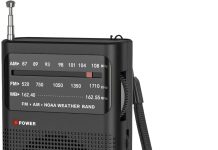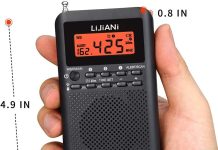Wondering whether emergency radios require programming or preset channels? Look no further, we have the answers you need. In times of crisis, having a reliable communication tool is crucial, and emergency radios have proven to be a lifesaver. But understanding how they work can be confusing. That’s why we’re here to clear up the confusion and provide you with the essential information. So, let’s dive in and explore whether emergency radios need programming or preset channels to ensure effective communication in emergency situations.
Review contents
Programming vs Preset Channels
Emergency radios are essential tools for communication during emergencies and natural disasters. They provide a means of communication when regular communication channels fail or are unavailable. One of the key considerations when purchasing an emergency radio is whether it requires programming or comes with preset channels. Understanding the differences and advantages of programming and preset channels is crucial in making an informed decision.
Definition and Explanation
Programming refers to the ability to manually select and store specific frequencies or channels on an emergency radio. This allows users to customize their radio’s settings and prioritize specific channels or frequencies based on their needs. On the other hand, preset channels are preloaded channels that come with the radio, typically programmed by the manufacturer or emergency response organizations. These channels are preselected based on their relevance and importance during emergencies.
Advantages of Programming
One significant advantage of programming is the flexibility it offers. By programming your emergency radio, you have the ability to prioritize the channels that are most important to you. This customization ensures that you have easy access to the frequencies and channels that you use frequently or are specific to your location. Programming also allows you to add and store new channels as needed, giving you more control over your communication options.
Another advantage of programming is the ability to program emergency response systems’ frequencies. Many emergency response organizations, such as police, fire, and medical services, use specific frequencies for communication. By programming these frequencies into your emergency radio, you can stay updated on vital information and receive real-time updates during emergencies.
Advantages of Preset Channels
Preset channels offer convenience and ease of use. They come preloaded with essential and commonly used channels, making it simple for users to access important information without the need for manual programming. With preset channels, you can quickly tune into emergency broadcasts, weather updates, and local news channels with just a few clicks.
Another advantage of preset channels is the reliability they provide. These channels are often selected by experts and emergency response organizations, ensuring that they are relevant and crucial during emergencies. The preset channels are updated regularly to ensure that users have access to the latest information and broadcasts.
Programming Emergency Radios
What is Programming?
Programming an emergency radio involves manually selecting and storing specific frequencies or channels. This process allows users to customize their radio’s settings while prioritizing the channels that are most important to them. By programming, users can ensure that they have access to the frequencies and channels that are relevant to their location and needs.
Types of Programming
There are two main types of programming for emergency radios: manual and computer-based programming. Manual programming involves directly inputting the frequencies or channels using the radio’s interface and controls. This method is straightforward but can be time-consuming, especially if multiple frequencies need to be programmed.
Computer-based programming, on the other hand, involves using specialized software or programming cables to connect the radio to a computer. This method allows for quicker and more efficient programming as frequencies and channels can be inputted and managed through the computer. It is particularly useful for radios with complex programming requirements or for users who need to program multiple radios simultaneously.
Process of Programming
The process of programming an emergency radio varies depending on the make and model of the radio. However, the general steps usually involve accessing the programming mode, entering the desired frequencies or channels, and storing them in the radio’s memory.
To begin programming, users typically need to put the radio into programming mode by following specific instructions provided in the radio’s user manual. Once in programming mode, users can then enter the frequencies or channels manually or using computer-based software. After inputting the desired frequencies, they can save and store them in the radio’s memory locations.
It is essential to follow the manufacturer’s instructions and guidelines carefully during the programming process to ensure accurate and reliable results. Additionally, it is advisable to keep a record of the programmed frequencies for future reference or in case of any system resets or changes.
Preset Channels in Emergency Radios
Definition of Preset Channels
Preset channels in emergency radios are preloaded channels that come with the radio. These channels are typically selected and programmed by the manufacturer or emergency response organizations. They are chosen based on their relevance and importance during emergencies, providing users with quick and easy access to essential information.
Preset channels often include emergency broadcast channels, weather alert frequencies, local news stations, and communication frequencies used by emergency response organizations. These channels are preselected to ensure that users have access to critical information and can stay updated during emergencies.
Availability of Preset Channels
The availability of preset channels varies depending on the make and model of the emergency radio. Some radios come with a limited number of preset channels, while others offer a wide range of preloaded channels to choose from. Higher-end models may even allow users to modify or add preset channels to suit their specific needs.
When considering a radio with preset channels, it is important to research and ensure that the provided channels align with your location and the emergencies you are most likely to encounter. Different regions may have different channels designated for emergency broadcasts and response systems, so it is crucial to choose a radio that covers the relevant frequencies for your area.
Benefits of Preset Channels
Preset channels offer several benefits, especially for users who prioritize convenience and simplicity. One of the main advantages is the ease of access to important information. With preset channels, users can quickly switch between emergency broadcast channels, weather alerts, and local news stations without the need for manual programming. This ensures that users can stay informed during emergencies without the hassle of searching for relevant frequencies or channels.
Another benefit of preset channels is the reliability they provide. Since these channels are selected by experts and emergency response organizations, users can trust that they are essential for communication during emergencies. Preset channels are regularly updated to ensure that users have access to the latest information and broadcasts, enhancing the overall reliability of the radio.
Factors to Consider
When deciding whether to opt for programming or preset channels on an emergency radio, several factors should be taken into consideration. These factors can help determine the most suitable option based on accessibility to information, user expertise, and compatibility with emergency response systems.
Accessibility to Information
Consider the level of accessibility to information that programming or preset channels provide. If you have specific frequencies or channels that are crucial for your location or emergencies, programming allows you to prioritize and store them for quick access. On the other hand, preset channels offer convenience by providing preloaded channels that are commonly used during emergencies.
To ensure optimal accessibility to information, it is important to research and understand the frequencies and channels used by emergency response organizations in your area. This will help determine whether programming or preset channels better meet your communication needs during emergencies.
User Expertise
Consider your level of expertise in programming and operating emergency radios. If you are familiar with radio programming and confident in handling the technical aspects, programming may be a suitable option for you. This allows for customization and flexibility in selecting frequencies or channels based on your knowledge of the communication systems in your area.
However, if you are not comfortable with programming or lack the necessary technical knowledge, preset channels may be a better choice. These preloaded channels provide a user-friendly experience, allowing you to access important information without the need for manual programming.
Emergency Response Systems Compatibility
Consider the compatibility of the emergency radio with local emergency response systems. Certain regions may have specific frequencies designated for emergency communication, and it is crucial to ensure that the radio you choose can support these frequencies.
Programming offers the advantage of being able to program the frequencies used by local emergency response systems directly into your radio. This ensures that you can receive real-time updates and stay connected during emergencies. Preset channels, on the other hand, may not always include these specific frequencies, so it is essential to verify their compatibility before making a decision.
Choosing the Right Option
Choosing between programming and preset channels ultimately comes down to personal preference and the specific needs of the user. Consider the following factors when deciding which option is the most suitable for you:
Considerations for Programming
If you prioritize customization and flexibility, programming may be the right choice for you. Programming allows you to select, store, and prioritize specific frequencies and channels that are relevant to your location and emergencies. It is particularly beneficial if you have a strong understanding of the communication systems used in your area and want the ability to add or modify channels as needed.
Considerations for Preset Channels
If convenience and simplicity are your main priorities, preset channels may be the better option. With preset channels, you can quickly access important information without the need for manual programming. These preloaded channels are often selected by experts and emergency response organizations, ensuring that you have access to reliable and up-to-date information during emergencies.
Hybrid Options
Some emergency radios offer a combination of programming and preset channels, allowing users to enjoy the benefits of both options. These hybrid radios typically come with preset channels for essential communication needs while also offering the ability to add or modify channels through programming. This provides a balance between convenience and customization, making it a suitable choice for users who want flexibility without compromising simplicity.
When choosing the right option, it is crucial to assess your individual needs, expertise, and the compatibility of the radio with local emergency response systems. By considering these factors, you can make an informed decision that ensures effective communication and preparedness during emergencies.
Programming Emergency Radios Yourself
Advantages and Disadvantages
Programming an emergency radio yourself offers several advantages. One significant advantage is the ability to prioritize and store specific frequencies or channels that are relevant to your location and emergencies. This ensures that you have quick and easy access to the information you need most.
Self-programming also allows for customization and flexibility. You can add or modify channels based on your communication preferences and update them as needed. This level of control ensures that your emergency radio caters to your specific communication needs, increasing its effectiveness during emergencies.
However, self-programming may also pose challenges for individuals who lack technical knowledge or experience. The process can be complex and time-consuming, especially for radios with extensive programming requirements. It requires careful attention to detail and adherence to manufacturer instructions. If not done correctly, programming errors can result in the radio being unable to receive important broadcasts.
Steps to Program an Emergency Radio
The exact steps to program an emergency radio may vary depending on the make and model of the radio. However, the general process involves the following steps:
-
Read the user manual: Familiarize yourself with the radio’s programming instructions and guidelines provided by the manufacturer. This will ensure that you understand the specific steps required for your particular radio model.
-
Gather relevant information: Determine the frequencies or channels that are relevant to your location and emergencies. Research the frequencies used by emergency response organizations and other essential channels to ensure that you have accurate information for programming.
-
Access programming mode: Put the radio into the programming mode as specified in the user manual. This typically involves pressing specific buttons or navigating through the radio’s menu options.
-
Enter frequencies or channels: Enter the desired frequencies or channels manually using the radio’s interface and controls. Take care to input the correct values and double-check for any errors.
-
Save and store programmed channels: Once the frequencies or channels are entered, save and store them in the radio’s memory locations as instructed in the user manual. This ensures that the programmed channels can be readily accessed when needed.
-
Test programmed channels: After programming, test the channels to ensure they are functioning correctly. Tune into the frequencies and check for reception and clarity. Make any necessary adjustments or corrections if issues are encountered.
It is important to remember that programming an emergency radio yourself requires attention to detail and accuracy. If you are unsure about any step or encounter difficulties, it is advisable to seek assistance from a knowledgeable individual or professional.
Professional Programming Services
Benefits of Professional Programming
Professional programming services offer a convenient and reliable option for programming emergency radios. These services are often provided by experts who have in-depth knowledge and experience in programming various radio models. By opting for professional programming, you can benefit from their expertise and ensure accurate and efficient programming.
One significant advantage of professional programming is the time-saving aspect. Programming an emergency radio can be time-consuming, especially for individuals who are unfamiliar with the process or have complex programming needs. By utilizing professional services, you can save valuable time and have the assurance that your radio is correctly programmed.
Furthermore, professional programmers are knowledgeable about the frequencies and channels used by local emergency response systems. They can ensure that your radio is programmed with the most up-to-date and relevant channels. This guarantees that you have access to critical information, enhancing your communication capabilities during emergencies.
Costs and Limitations
Professional programming services may incur additional costs, especially if you require customized programming or have multiple radios that need to be programmed. The exact cost of the service can vary depending on the complexity of the programming requirements and the service provider.
It is also important to note that professional programming services may have limitations in terms of their availability. Depending on your location, there may be a limited number of providers, which could result in potential delays or limited access to these services.
Before opting for professional programming, it is advisable to research and compare different service providers to ensure that they meet your specific needs and requirements. Additionally, consider the cost-effectiveness of professional programming compared to the benefits it offers.
Using Preset Channels on Emergency Radios
Preloaded Channels
Preset channels are preloaded channels that come with the emergency radio. These channels are typically selected by the manufacturer or emergency response organizations based on their relevance and importance during emergencies.
The specific preloaded channels can vary depending on the make and model of the radio. However, common preset channels typically include emergency broadcast channels, weather alert frequencies, local news stations, and communication frequencies used by emergency response organizations.
These preloaded channels provide users with a convenient and accessible way to access important information during emergencies. With just a few clicks, users can tune into emergency broadcasts or receive weather updates without the need for manual programming.
Editing or Adding Preset Channels
Some emergency radios allow users to edit or add preset channels, providing additional customization options. This can be beneficial if there are specific channels that you want to include or modify based on your communication needs.
To edit or add preset channels, users typically need to access the radio’s programming mode or menu. From there, they can navigate through the options to edit existing preset channels or add new ones. It is important to follow the manufacturer’s instructions provided in the user manual to ensure accurate and reliable programming.
By editing or adding preset channels, users can tailor their emergency radio to their specific communication preferences. This level of customization enhances the usability and effectiveness of the radio during emergencies.
Locking and Unlocking Channels
Some emergency radios offer the ability to lock or unlock preset channels. Locking a channel prevents accidental changes or deletions, ensuring that the preset channels remain intact. This can be particularly useful for users who want to avoid unintentional modifications to the channels during emergency situations.
To lock or unlock preset channels, users will need to access the radio’s settings or programming mode. From there, they can navigate through the options to enable or disable channel locking. It is advisable to consult the user manual for specific instructions on how to lock or unlock channels on your particular radio model.
Locking channels provides an extra layer of security and stability to your emergency radio’s settings. By preventing accidental changes, users can rely on the preset channels to provide consistent access to critical information during emergencies.
Maintenance
To ensure the optimal functionality of your emergency radio, regular maintenance is essential. This includes updating radio frequencies, monitoring battery and power considerations, as well as conducting regular checks and tests.
Updating Radio Frequencies
Keeping the radio frequencies up to date is crucial for accurate and reliable communication during emergencies. Frequencies used by emergency response organizations or local authorities may change over time, and it is important to stay informed about any updates or modifications.
Regularly check with relevant local authorities or emergency response organizations for any changes or updated frequencies. This ensures that your emergency radio remains aligned with the current communication systems, enhancing its effectiveness during emergencies.
Battery and Power Considerations
Maintaining sufficient battery life and power supply is vital to ensure your emergency radio is always ready for use. Regularly check and replace batteries as needed, ensuring that they are functioning correctly and have enough charge. Keep spare batteries on hand in case of emergencies or extended power outages.
If your emergency radio has a rechargeable battery or operates on external power sources, ensure that the battery is charged or the power supply is available. Regularly test the rechargeable battery and power source to ensure they are in working order and can meet your communication needs during emergencies.
Testing and Regular Checks
Regularly conduct tests and checks to ensure that your emergency radio is in proper working condition. This includes testing reception, audio quality, and the functionality of preset channels or programmed frequencies.
Perform scheduled tests to verify that the emergency radio can effectively receive broadcasts from emergency response organizations and weather alerts. Check the clarity of the sound output and ensure that there are no issues with the radio’s speaker or audio settings.
Additionally, periodically review and update your preset channels or programmed frequencies based on any changes or new information. Regularly check and verify the accuracy of the stored frequencies to ensure that they are still relevant and compatible with local emergency response systems.
By conducting regular checks and tests, you can identify any potential issues or malfunctions in your emergency radio and address them promptly. This ensures that the radio is in optimal working condition when emergencies arise.
Conclusion
When choosing between programming and preset channels for your emergency radio, it is crucial to consider various factors, including accessibility to information, user expertise, and compatibility with emergency response systems. Programming offers customization and flexibility, allowing users to prioritize specific frequencies and channels. On the other hand, preset channels provide convenience and reliability, offering preloaded channels that are commonly used during emergencies.
Consider your personal preferences, expertise, and the specific needs of your location and emergencies to make an informed decision. Hybrid options that combine programming and preset channels can also be suitable for users who desire flexibility without compromising simplicity.
Whether you choose to program your emergency radio yourself or opt for professional programming services, ensure that the frequencies and channels are accurate, up to date, and aligned with local emergency response systems. Regular maintenance, including updating radio frequencies, monitoring battery and power considerations, and conducting tests, is vital to ensure optimal functionality.
Ultimately, the choice between programming and preset channels depends on your individual needs and preferences. By considering the factors outlined in this article, you can make an informed decision and ensure effective communication during emergencies.



























